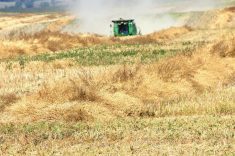Don’t tell Hugh Campbell soybeans won’t grow in Saskatchewan.
His research and development company, Terramax Corporation of Qu’Appelle, Sask., planted between 30 and 40 varieties this year.
Some look very promising, he said.
“The experts say it can’t be done,” Campbell said in an interview. “We are moving ahead.”
Some believe soybeans can’t be grown in the province because they aren’t traditionally suited to its lower heat units, cool evenings and shorter growing season.
American varieties that can do well in southern Manitoba “didn’t come within a mile of making it” in Saskatchewan, Campbell said.
Read Also

Alberta researcher helps unlock the economics of farming
Lethbridge Polytechnic researcher helping agriculture producers with decision-making tools in economic feasibility
But other varieties present opportunities. His research focuses on developing plants that mature earlier.
Two years ago, he planted more than 90 varieties. Last year, there were about 70.
“We’ve got some that are dead ripe and some that are dead green,” Campbell said of the varieties in this year’s plots at Qu’Appelle.
The growing season was anything but ideal for heat-loving soybeans. The Qu’Appelle plots received double the normal annual rainfall both last year and this year, and the summers were cool. The crop is two to three weeks late, he said, so the earliest maturing varieties are just ripe now. Recent rain has delayed harvest.
Terramax plots harvested in South Dakota and Manitoba show good yields despite weather challenges. They averaged 36 bushels per acre.
At previous test plots near Outlook, Sask., soybeans under irrigation yielded about 50 bu. per acre.
Campbell said the newer varieties are maturing between 100 and 120 days, although some have been earlier. This compares to 130 days for other types.
Most of Campbell’s work is in the research and testing stage, but there is limited commercial production. He said there is still a lot to learn about soybeans, but the crop could be a valuable option and is worth pursuing.
“Soybeans are worth about $5 (US) a bushel, or $7 Canadian,” he said. “It’s a relatively easy crop to grow and manage. Soybeans are remarkably farmer-friendly.”
Producers don’t require any new equipment to seed and harvest soybeans. There are herbicides registered for weed control, and there is a well-established international market.
Campbell said the United States grows about 80 million acres each year and Brazil grows almost as much.
“If we were to find this an adaptable crop, putting three to four million acres into production wouldn’t affect anything,” he said. “We won’t see a (price) crash like peas.”















